AI has come a long way in helping us generate content, but one common challenge still trips people up: creating consistent characters. Many of us struggle with maintaining character consistency across our AI designs, especially when trying to build a cohesive story or video that centers around the same character.
Yet, this isn't something that you should be stressing over! It's totally fixable if you know how to approach it strategically. Below, we will address this problem and share some of the most effective methods to ensure that every character you create with AI remains consistent.

In this article
Part 1. What Makes AI Characters Inconsistent?
Having consistent characters is key to making a believable narrative. But when we use AI to help us make these characters, we often find that the results can vary significantly. This inconsistency can disrupt the flow of your story and diminish the connection your audience has with the characters.

But why is it challenging to create consistent characters with AI? There are several common reasons behind it:
AI Loves Variety
AI models learn from tons of different examples, so they're exposed to a whole spectrum of styles. This means they can sometimes get a bit creative in ways we didn't intend, leading to unexpected changes in how characters appear.
Characters Are Complex
There's a lot to a character—how they smile, the way they furrow their brows, their typical gestures. Getting an AI to keep these features consistent every time can be tricky, as it might catch some nuances but miss others.
Guidelines? What Guidelines?
If we don't give AI clear instructions on what our characters should consistently look like, it might make its best guess based on what it has learned—and that might not always match up with our vision.
Tech Updates
AI is always improving, which is great! But as models get updated, the way they interpret instructions can change too. If we're not careful, a character that started out one way might evolve into something else.
Getting to grips with these challenges helps us think about how we can better guide AI to produce the characters we envision. The next question is, what can we do to address them? Find the answer in the next section!
Part 2. How to Create Consistent Characters with AI
Creating consistent AI characters can be challenging, but there are practical steps to ensure your characters stay visually and narratively coherent across different scenes. It starts with using the right AI tools—that foundation is key. One highly recommended tool for this purpose is Wondershare Filmora. Its AI Idea to Video feature allows you to easily build story-based videos featuring your AI-generated characters, ensuring consistency in both appearance and context. Depending on your storytelling needs, you can also choose your preferred story duration—from Auto, to 10–20 seconds (default), or even 20–30 seconds.
By combining the right strategy with the right tool, you can tackle the challenge of character consistency with confidence and creativity.
🧠 Step-by-Step Guide to Creating Consistent AI Characters:
Step 1Define Your Character Clearly
Develop a detailed description specifying attributes such as age, gender, hairstyle, clothing, facial features, and any unique identifiers. Establishing a backstory can further inform consistent visual elements.
Step 2Generate Reference Images
leverage Filmora's AI Image Generator to transform text descriptions into high-quality images.
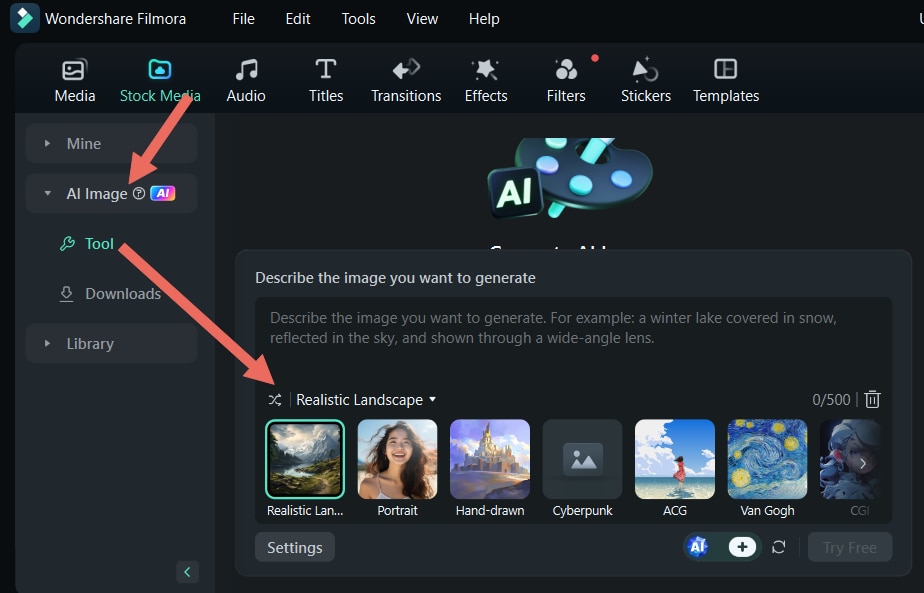
Step 3Enter the "AI Idea to Video" Interface from the Startup Page
Once you have made consistent characters with AI, it'd be a great opportunity to start building stories around them. You can place them in different settings, give them unique personalities, and create engaging plots that showcase their traits.
On the startup page, find the "AI Idea to Video" feature box and click to enter.
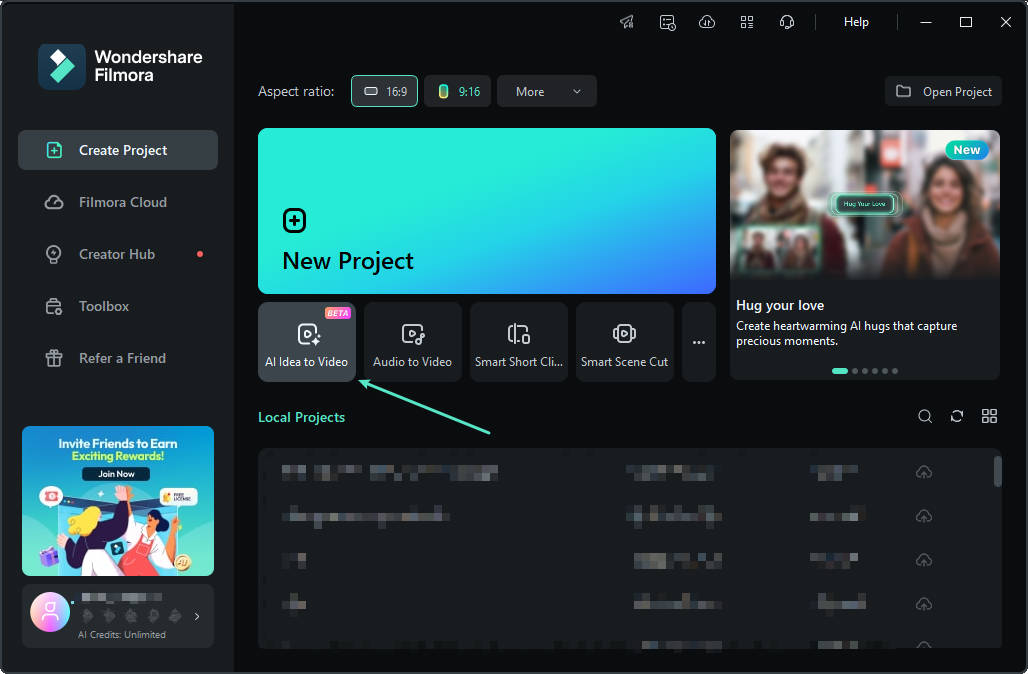
Step 4Edit Your Story Content
After entering the "AI Idea to Video" feature interface, you can input your story idea and customize the video length, language, and style. Once the settings are complete, click "Launch AI Script."
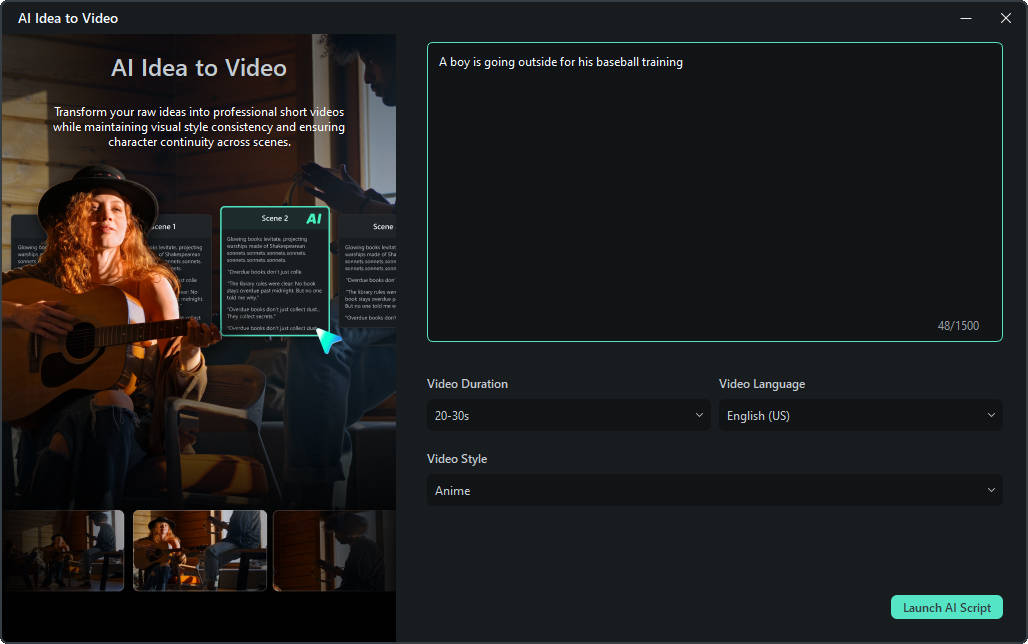
Step 5Use the Keyframe to Video Method
Upload two images—one for the beginning and one for the end—and Filmora will help generate everything in between, ensuring smooth transitions and consistent character portrayal.

Step 6Refine and Edit The Generated Video
Thankfully, with Filmora's AI Idea to Video feature, continuing the process is simple. After confirming your storyboard reference images and character designs, you'll move on to setting up the final video generation details, such as:

- Video Aspect Ratio: Choose between 16:9 (ideal for YouTube or desktop viewing) or 9:16 (perfect for mobile and social media stories).
- Sound Effects: Filmora automatically adds background sounds and event-specific effects based on your video's content, so you don't have to start from scratch.
- Voiceover: Convert your script to speech using the TTS (Text-to-Speech) feature. You can choose from a variety of free voice options to best match your characters and tone.
- Transitions: The system randomly applies transitions from a predefined list to ensure smooth progression between scenes. These transitions can be used multiple times within the same video.
Part 3. How to Use Image References and Prompts to Keep AI Characters Consistent
To make your AI characters visually consistent across multiple scenes or projects, it's essential to go beyond just using the same tool. In this section, you'll learn how image references and detailed prompts can help guide AI results more accurately, ensuring your characters look and feel the same every time.
Using Image References
Next, it will be more likely to have AI consistent characters if you provide image references. As mentioned briefly, you can generate corresponding reference images for each storyboard scene in Filmora AI Idea to Video. Within this feature, you can choose from the following options:
- Generate a reference image
- Upload a local reference image
- Generate with the keyframe method
- Generate with reference video
This way, your AI-generated characters will align more closely with your vision, maintaining visual coherence across all scenes!
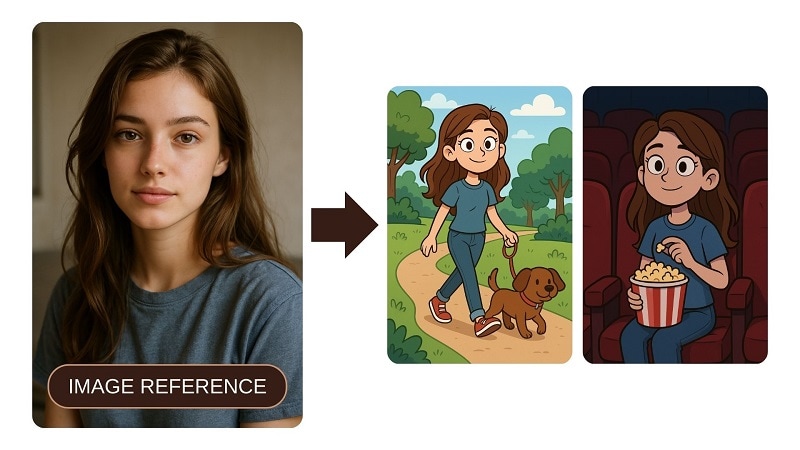
Prompt Tip
If you have the option to add a prompt when generating content with AI, seize this chance to guide the results! Be as clear and detailed as possible. This will help the AI create characters that look and feel the same each time.
To make a consistent character with AI, try using these helpful tips when writing your prompt:
- The More Details, The Better: Include things like hair color, outfit, eye shape, personality, or even accessories your character always wears.
- Set the Scene: Add a brief setting or background if it supports the look or feel of the character. This gives the AI more context to work with.
- Stick to the Same Words: Use the same phrases every time you describe your character. This helps the AI "remember" what they're supposed to look like.
- Avoid Being Too Vague: Try not to say things like "a cool character." Instead, go for something like "a confident teen with a red jacket and short brown hair."
- Reference Previous Prompts: If you've had success with a previous prompt, save it and reuse it. Small tweaks are okay, but keeping the core description the same helps maintain consistency. Phrases like "use the same character" can also be useful!
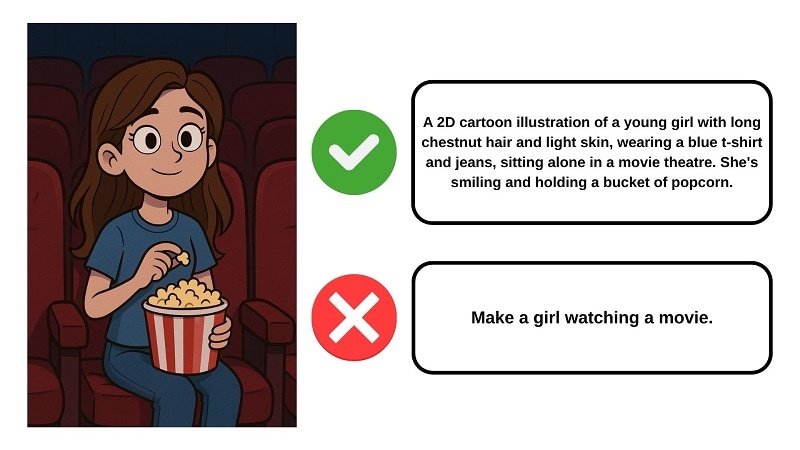
Conclusion
Creating consistent AI characters is one of the biggest challenges in AI-generated content, even though it plays a key role in building a strong and believable narrative. It might feel tricky at first, but once you understand the common issues and use the right tools and strategies, it becomes much more manageable.
By combining strong image references, detailed prompts, and an AI-powered video editor like Filmora, you'll have everything you need to create consistent characters who look and feel the same, scene after scene. Try experimenting with different stories and styles, and let Filmora help you realize your ideas with creativity and consistency!



 100% Security Verified | No Subscription Required | No Malware
100% Security Verified | No Subscription Required | No Malware


